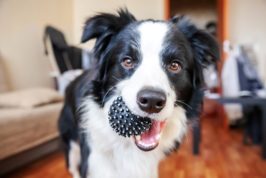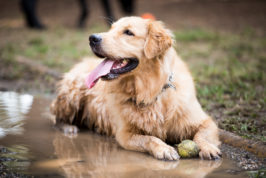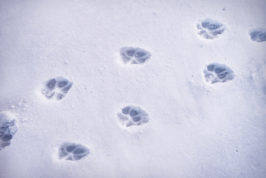Cruciate ligament rupture in dogs: causes and treatments
If your dog has torn its cruciate ligament, you’re probably wondering what to do next. In this article, Dr Joanna Woodnutt explains the diagnosis and treatment options, and what you can do at home to help…
What is the cruciate ligament?
Your dog has two ligaments in his knee joint, both of which are called the cruciate ligaments. The cranial cruciate ligament is the one that’s usually damaged (you may also hear it called the anterior cruciate ligament), and it runs from the back of your dog’s thigh bone (femur) to the front of their shin bone (tibia). Its purpose is to stop the femur ‘sliding off’ the tibia when your dog puts weight through the limb. You can read more about your dog’s cruciate ligament in our article here.
Signs of cruciate ligament rupture in dogs
So, how can you tell if your dog has ruptured their cranial cruciate ligament?
Well, the most common sign is a limp in one of the back legs (Hindlimb Lameness). It’s usually quite severe, with dogs reluctant to even touch their toe to the ground when standing or walking. However, mild lameness can also occur, especially in a partial tear.
You may also notice:
- Stiffness when rising or reluctance to move
- Licking of the knee area
- Swelling in the knee
Diagnosing cruciate ligament damage
Examination and history
Cruciate Ligament Disease can be difficult to diagnose in some dogs. Whilst theoretically, the knee should be extremely unstable and should move abnormally during the exam (called a cranial drawer), this isn’t always the case. In practice, dogs can be reluctant to allow examination of a painful knee, or they may tense, making the necessary manipulations of the knee difficult.
X-rays
Your vet will then need to x-ray your dog to get more information. This can rule out other issues, such as Hip Dysplasia, Arthritis, Bone Cancer, and bone breaks (fractures), as well as give information about the severity of the problem. Ligaments don’t show up well on an x-ray, but your vet can use clues like the amount of joint swelling to determine what’s going on.
Your dog will actually need several x-rays on each leg, and both legs will need to be x-rayed to check for other problems. The hips should also be checked, as Hip Dysplasia (a deformity of the hip) is common.
Because these x-rays all require weird and wonderful positioning and your dog must lie completely still, they will be sedated or given an anaesthetic for the duration. Your vet will probably examine your dog’s leg again whilst they’re asleep, bending the knee and putting force through the leg to see whether there is instability and/or a cranial drawer.
Arthroscopy

For complicated cases, or for investigating suspected partial tears, a tiny camera called an arthroscope can be pushed into the joint to look at the ligament and diagnose a problem.
Treatment options for Cruciate Ligament Disease
There are a few different options for treatment of cruciate ligament problems, and which is best for your dog will depend on their size, activity level, age, and any other medical problems they have.
Surgical treatment
Most dogs diagnosed with a cruciate problem go to surgery, and there are several different types that can be carried out.
For small dogs, a lateral suture, or, lateral fabella suture, can be used. This technique involves placing a strong band of suture material between the femur and tibia, effectively replacing the ligament. It’s relatively cheap to do, and may not require a visit to a specialist, but it does have some downsides. The suture can snap, meaning a second surgery, and it’s less successful in larger dogs. In general, owners of dogs with a lateral suture are less happy with their dog’s recovery.
For a better outcome, an osteotomy (bone cutting) surgical technique is preferred. There are several different types your vet may discuss – Tibial Tuberosity Advancement (TTA) and Tibial Plateau Level Osteotomy (TPLO) are common, but newer techniques such as CORA-based Levelling Osteotomy (CBLO) are becoming more popular.
Although they all have minor differences in how they’re carried out, these surgeries all involve cutting the bone and re-attaching it in such a way as to prevent the femur from sliding over the tibia. They usually require an advanced surgeon with tools not available to most vets, so you may have to travel to another practice.
Whilst complications with the surgery or with healing can occur, the outcome is generally better for these surgeries than a lateral suture.

Non-surgical treatment options
‘Conservative management’ or ‘medical management’ may be appropriate for some dogs, especially small dogs, those who are not severely lame, or elderly dogs with another condition that makes surgery difficult. Whilst the cruciate ligament cannot heal, conservative management aims to improve symptoms. In a survey of vets, conservative management options for cruciate disease included:
- Pain relief
- Weight loss
- Short walks on the lead
- Cage rest
- Hydrotherapy and physiotherapy
- Use of joint supplements
Specially-made knee braces have also been used to help dogs cope with their unstable joints, and may be useful for dogs where surgery is not an option. However, nearly half of dogs had skin issues from the brace, and one in 10 had to go on to have surgery anyway.
If you and your vet decide that conservative management is a better option for your dog, be sure to follow their instructions closely, and book regular check-ups to assess how your dog is faring.
How to look after a dog who’s had cruciate surgery
If your dog has had cruciate surgery, their home care is an important part of their rehabilitation. Different vets will do things slightly differently, and the care will depend on the exact surgery your dog has had. However, it’s likely you’ll be asked to consider the following…
Cage rest
You may have to confine your dog to a crate, which is the equivalent of bed rest for humans. If your vet asks to you cage rest your dog, find out how long for, and how strict the rest should be – for some operations, your dog should not be allowed out of their crate except when going on the lead to go out to the toilet.
Non-slip floors
I cannot stress enough how damaging a slippery floor is in dogs that are unsteady on their feet. Even if they don’t fall down all the way, a slight slide puts extra strain on their joints and muscles, which are probably under-muscled after disuse. If you have hard floors, get some rubber-backed mats so your dog has a suitable surface to walk on.
Medications
Your dog should be sent home with pain relief. Depending on the surgery and the individual dog’s response to pain, this can vary from an NSAID up to Tramadol or Gabapentin. Follow your vet’s instructions on frequency and how many to give, and ask them if you aren’t sure. If you aren’t already giving a joint supplement, it’s likely your vet will recommend one.
Hydrotherapy and physiotherapy
Your vet will advise when you can start hydrotherapy and physiotherapy. Both are great ways to keep your dog moving and keeping their muscles toned whilst not putting excess pressure on your dog’s healing bone.

Follow-up visits
Your dog will need to have follow up visits with your vet. It’s likely they’ll have one or two within the first week, to make sure the wound is healing as expected and things aren’t too painful. They’ll also need follow-up x-rays to ensure the bone is healing as expected –usually at around eight weeks.
Conclusion
It’s common for cruciate ligaments to rupture, so it’s worth being aware of the signs of a problem. Your vet will need to do x-rays to diagnose cruciate rupture, and you’ll then need to decide whether or not to have surgery done. Whilst surgery is generally recommended for most dogs, it might be less suitable for others – talk to your vet or an orthopaedic specialist about your options.





Brilliant site. Very informative. Thanks.